Production and Marketing of Cucumber in Some Selected Areas of Mymensingh District
Aziza Lutfa , Fardous Ara Happy2*, Farjana Yasmin2 and Hasibur Rahaman Hera3
1Department of Agribusiness and Marketing, Bangladesh Agricultural University, Mymensingh, Bangladesh
2Department of Agricultural Economics, Bangladesh Agricultural University, Mymensingh, Bangladesh
3Department of Pathology, Bangladesh Rice Research Institute, Gazipur, Bangladesh
Submission: December 22, 2017; Published: May 04, 2018
*Corresponding author: Fardous Ara Happy, Department of Agricultural Economics, Bangladesh Agricultural University, Mymensingh, Bangladesh, Email: fardoushappy83@gmail.com
How to cite this article: Aziza L, Fardous A H, Farjana Y,Hasibur R H. Production and Marketing of Cucumber in Some Selected Areas of Mymensingh District. Agri Res & Tech :Open Access J. 2018; 15(5): 555969.DOI:10.19080/ARTOAJ.2018.15.555570
Abstract
The present study was undertaken to estimate the production and marketing of Cucumber. The data were collected from Baliarmor in Phulpurupazilla and Mymensingh city from Mymesingh district. Primary data were collected from 30 farmers from PhulpurUpazila, 7 wholesaler, 7 retailers and 6 local traders. Purposive sampling technique was used to select the cucumber producers and convenience sampling was used for selecting traders. Production of cucumber is profitable in the study areas. Per acre net margin of producing cucumber was Tk.43162.71. Total marketing cost per acre cucumber was highest for local traders (Tk. 2.73) and lowest for retailers (Tk.1.57). There were 5 marketing channels in Mymensingh district, including different intermediaries like local traders, wholesaler and retailer. The net marketing margin was highest for retailers (Tk.2.65) and lowest for wholesaler (Tk. 0.58). The seasonal price index of cucumber was the highest 135.67 in the month of October i. e., price of cucumber is 35.67 per cent higher than average price in this month and the lowest was Tk.60.62 in May i.e., price is 39.38 per cent less than average price in this month. The study also indicated some problems and constraints of cucumber cultivation and marketing, such as: lack of capital, high price of fertilizers and insecticides, lack of scientific knowledge and training, lack of storage facilities, attack by diseases, low market price, fluctuation of demand, etc. Based on the findings, some recommendations were suggested to improve the situation for cucumber production and marketing with a view to increase the income and employment opportunities of the cucumber farmers.
Keywords: Cucumber; Production and marketing; Local traders; Wholesaler and retailer
Introduction
Cucumber is a popular cultivated plant in the gourd family Cucurbitaceae that managed to captivate our attention from the moment it appeared in ancient India. Since that pivotal moment over 4000years ago, cucumber was spread beyond Indian borders, moved through Ancient Greece, Rome, Europe, New World, China, and eventually becoming fourth most widely cultivate vegetable in the world. This journey was filed with golden periods when they were viewed as integral parts of many culture's cuisines, and sometimes they were treated as bringers of disease. Agricultural is the dominant sector of the Bangladesh economy and growth and stability of Bangladesh depends largely on the growth of agriculture. About 60-75percent people of Bangladesh fully and partially depend on Agricultural sector. In Bangladesh about 22286 acres of land is under cucumber cultivation and total production is approximately 54854 metric tons [1]. Thus, the average yield of cucumber is about 55 quintal per hectare which is very low compared to those of other countries of the world. It has scope to decrease this quantity of import but the fact is the absence of high yielding cultivars of cucumber and the improved method of cultivation. Since the soil and climatic condition of Bangladesh are suitable to cultivate cucumber, it is expected the selection of high yielding varieties will augment the yield considerably. Indeed there is a vast scope to increase cucumber production with the introduction of selected high yielding varieties.
Cucumber plays an important role to meet the vegetable shortage during the scarce period, which ultimately helps to improve the malnutrition problem in Bangladesh. It was found useful against human constipation and improvement in digestion. It is used as a cooling food in summer [2]. A fresh Cucumber provides vitamin C, niacin, iron, calcium, thiamine, fibers and phosphorus [3]. Besides, it is one of the very low-calorie vegetables; provide just 15calories per 100g. It is an excellent source of potassium, an important intracellular electrolyte. 100g of cucumber provides 147mg of potassium but only 2mg of sodium. Cucumbers contains unique antioxidants in moderate ratios such as ^-carotene and a -carotene, vitamin-C, vitamin-K vitamin-A, zeaxanthin, and lutein. It helps in checking weight gain and high blood pressure. More than 50% production of Cucumber comes from Asia. Turkey, Iran, Uzbekistan, Japan and Iraq were considered as leading Cucumber producing countries in Asia [3]. In Bangladesh it is grown as a cash crop but the farmers of Comilla, Bogra, Rangpur, Noakhali, Faridpur, Chittagong and Mymensingh districts grow cucumber commercially. There is a scope for cultivation of cucumber in the cultivable land during summer season. It is profitable and its net return per hectare is relatively higher.
Modalities of such impact have been described in a good number of literatures. A modest attempt has been made here to review the previous research studies which are: Nahar [4] conducted a study in Jessore district and the major findings of the present study were that the year round vegetables production was profitable from the viewpoints of marginal, small, medium and large farmers. Bean, cabbage, cucumber and snake gourd were mainly produced in the study areas and per ha net returns of producing these crops were Tk 89383, 90040, 90737.6 and 65473, respectively and undiscounted BCR came out to be 1.81, 1.87, 1.82 and 1.76 respectively which showed that vegetables production was profitable in the study area. The farmers tamed the highest profit from cucumber vegetables. Suraiya [5] made an economic analysis of some selected summer vegetables production in PurbadhalaUpazila of Netrakona District. Per ha net returns of producing cucumber, okra, white gourd and snake gourd were Tk 93452.0, 70380.0, 96896.0 and 58843.0.respectively. In other words, all the selected summer vegetables were highly profitable to their farmers. However, the farmers earned the highest profit from white gourd. Siful [6] who made his study in Mymensingh district find that cucumber is a profitable business. Gross returns per hectare for the corresponding categories of farmers were Tk. 2525200, 24500, 240000 and 245833.33 respectively. Per hectare yield of cucumber for small, medium, large and all farmers were 25250, 24500,2400 and 24583.33kg respectively. Parvin [7] conducted an economic study of alternative rice and vegetables production in selected area of Mymensingh District. Boro rice, A man rice, lady's finger, cabbage and white gourd were mainly produced in the study areas and per ha net returns of producing these crops were Tk 23581, 3896, 86898, 89640 and 99000, respectively. The farmers earned the highest profit from white gourd vegetables.
In the past a very few studies have been done on the production and marketing of cucumber in Bangladesh. But there was no exclusive study on the production and marketing of cucumber in Phulpurupazila. As such, it was felt that the study on the production of cucumber in some selected area of Mymensingh district would be of much importance. The findings of the study are likely to be helpful to the researchers and policy makers in the formulation of policies regarding production of cucumber in Bangladesh. The study may induce researchers to conduct further research in cucumber production. The overall objective of the study is to investigate the production and marketing of cucumber. The specific objectives are as follows:
ii. To examine the marketing system of cucumber;
iii. To estimate the marketing cost and margin of cucumber;
iv. To examine the seasonal price behavior of cucumber; and
Materials and Methods
The data were collected from Baliarmor in Phulpurupazilla and Mymensingh city from Mymesingh district. Primary data were collected from 30 farmers from PhulpurUpazila, 7 wholesaler, 7 retailers and 6 local traders. Structured questionnaire was used to collect data and year of experiment was 2017.
Analytical Technique
Seasonal price variation of cucumber
There are four methods of measuring the seasonal price variation i.e. simple average method, ratio to trend method, ratio to moving average method and link relative method. Among them, ratio to moving average method provides better result, because, it differs from the percentage of trend method in the sense that the original prices are expressed as percentage of the moving average instead of percentages of trend values. The 12-months moving average is a fairly good estimate of the trend and cyclical components combined. Therefore ratio to moving average provides an index of seasonal and irregular components combined because averaging this over years and adjustment through correction factor provides a better estimate of seasonal index [8]. The monthly grower's price of cucumber during 2007 to 2016 was collected from DAM database.
Profitability of cucumber
To show the performance of cucumber cultivation and other variables, the following profit equation was used to assess the profitability of cucumber cultivation:
π=Gross return - (Variable cost + Fixed cost)
Where,
π = Profit per acre
Gross Return, GR = Total volume of Production x per unit price
i. Variable costs
a. Cost of human labour sowing/planting,
b. Cost of seed,
c. Cost of fertilizers,
d. Cost of irrigation,
e. Cost of pesticides,
ii. Fixed costs
The fixed cost are given below:
a. Interest on operating capital (IOC)
Interest on operating capital was charged at the rate of 10 percent per annum and was estimated for duration of five months for cucumber cultivation. It was assumed that if the farmers borrowed the money from bank, they had to pay interest at the same rate. It was estimated by using the following formula [9] :
Interest on operating capital = AI x i x t
Where AI= (total investment)/2
i= rate of interest
t = length of crop period on months
The period of crop cultivation was considered from the time of land preparation to harvest. The interest actually means the average operating cost over the period as all the costs were not incurred at the same time; rather these were used throughout the production period from beginning to the end.
b. Land used cost
Land used cost varied from union to union depending upon the soil type, topography, location and security of the particular crop field. Lease value of land of the study area was considered as land use cost for the present study.
c. Gross return
Gross return was calculated by simply multiplying the total volume of output by it's per unit price in the harvesting period [10] . It consisted of sum of the volume of main product. The following equation was used to estimate Gross Return (GR):

Where,
π = Profit of cucumber production (Tk./acre),
Pf = per unit price of cucumber (Tk./kg),
Qf = quantity of cucumber (kg/acre),
PXi= per unit price of ith (variable) inputs,
X i = number/quantity of ith inputs,
i =1, 2, 3 ...n;and
TFC = Total Fixed Cost.
d. Marketing Margin
The formulas are:
Gross marketing margin =Sale price -Purchase price
Net marketing margin =Gross marketing margin -Marketing cost
Return on investment (%) = (Net marketing margin/ Total investment) x 100
Where, Total investment = Purchase price +Marketing cost
In the present study marketing margin was computed according to the second method. Marketing margins of different groups of intermediaries were calculated separately to examine their relative performance of marketing activities.
Result and Discussion
Costs and returns of cucumber production
Variable cost and fixed cost: Cost of human labour for sowing/planting is very high in Phulpurupazila. Cucumber farmers basically hired labour during the planting period. They also hired labour for weeding, harvesting, digging, assembling etc. purposes. Farmers spent approximately Tk.7048.39 per acre in season for labour purpose (10% of total cost). The cost of seed for cucumber production was Tk.2152.96 per acre (about 3% of total cost). The cost of Urea, TSP, MP and cow-dung during the season is Tk.10023.08, 27720.36, 3006.94 and 1966.85 per acre respectively (about 14, 40, 4,2% respectively). Farmers usually used shallow pump to irrigate their plants. They had to spend a good amount for this purpose which was approximately Tk.2711.11 per acre (about 4%). Cost of pesticides was approximately Tk.12500 per acre (about 18 per cent) The interest on operating capital was Tk.1006.94 (about 1% of total cost). Leasing cost of land is Tk.1500 per katha (8 decimal) per year. Here land used cost of cucumber production was calculated for 3months per acre and it was Tk.4687.5 which accounted 6.43% of the total cost. So the per acre cost of cucumber cultivation was about Tk.72824.16. Analysis shows highest cost goes to T.S.P (40%) purpose. Other costs of farmer in descending manner were pesticides cost, urea cost, and human labour cost (Table 1).

Source: Field survey, 2017
Marketing cost incurred by cucumber farmers
Total cost of marketing of cucumber per kg was Tk.1.73. The highest share went to transportation (57.80%). Marketing toll was 28.90%. Other costs of marketing is followed by Personal expenses (10.40%) and telephone cost (2.89%) (Table 2).
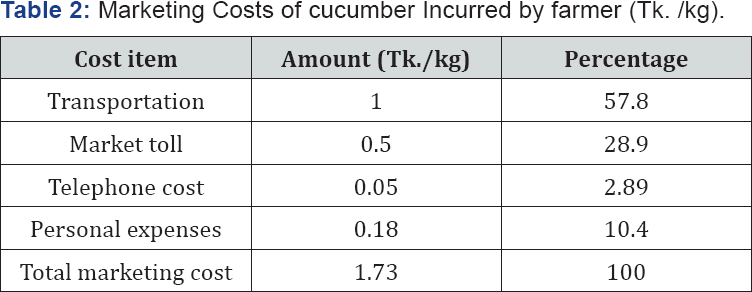
Source: Field survey, 2017.
Return from cucumber production
The obtained gross return was Tk. 115986.87 per acre. Per acre gross margin and net margin were Tk.48857.15 and Tk. 43162.71 respectively. BCR (Benefit Cost Ratio) was 1.59; which is greater than one; means cucumber cultivation is profitable (Table 3).
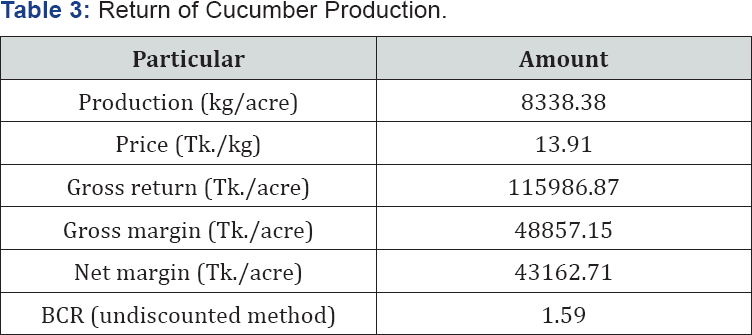
Source: Field survey, 2017.
Marketing system of cucumber
Marketing channels: Two marketing channels of cucumber in Phulpurupazila and there channels from Mymensingh city were identified. These are given below:
A. Marketing channels of cucumber in Phulpur:
Channel-I Producer→local traders→wholesaler→Retailer→Consumer Channel- II Producer→Consumer
B. Marketing Channel of cucumber in Mymensingh City
Channel-IProducer→ local trader → wholesaler →retailer consumer
Channel-IIProducer→ local trader →retailer →consumer
Channel-IIIProducer→ retailer consumer
Channel-IVProducer→local traders consumer
Channel-V Producer→local trader→retailer→street seller→consumer
Market participants
There are six market participants i.e., producer, local trader, whole saler, retailer, street seller and consumer.
The producers usually sold their cucumber to the local traders at the local market (Sosar bazar). Farmers and various intermediaries formed linkage in the channel. Local traders were professional traders who purchased cucumber from producers at the local market (sosar bazar). Purchased cucumber were packed those were consigned by truck to the wholesalers and retailers who were located at the Mymensingh city. They purchased cucumber from local traders and sold these to the retailer. They also sold cucumber to the producer. Their business premises were situated at the well communicated areas in the secondary market. Example: Basabari market in Mymensingh city. The retailers bought cucumber from local traders at farm level through wholesaler and sold those to the consumer and street seller. Sometimes they had no permanent shop, usually use open market place for selling cucumber. Most of the retailers had been doing business for more than ten years. The Street sellers are mainly school going boys and girls [11]. They usually collect cucumber from retailer through wholesaler and sell them to the direct user in the busy roads of Mymensingh city. Example: ganginar par, natun bazar, charpara. The consumers were the final buyers of cucumber They purchased cucumber from the market place but sometimes they also purchased these from wholesale market and in production area. Characteristics of different participants are shown in Table 4.
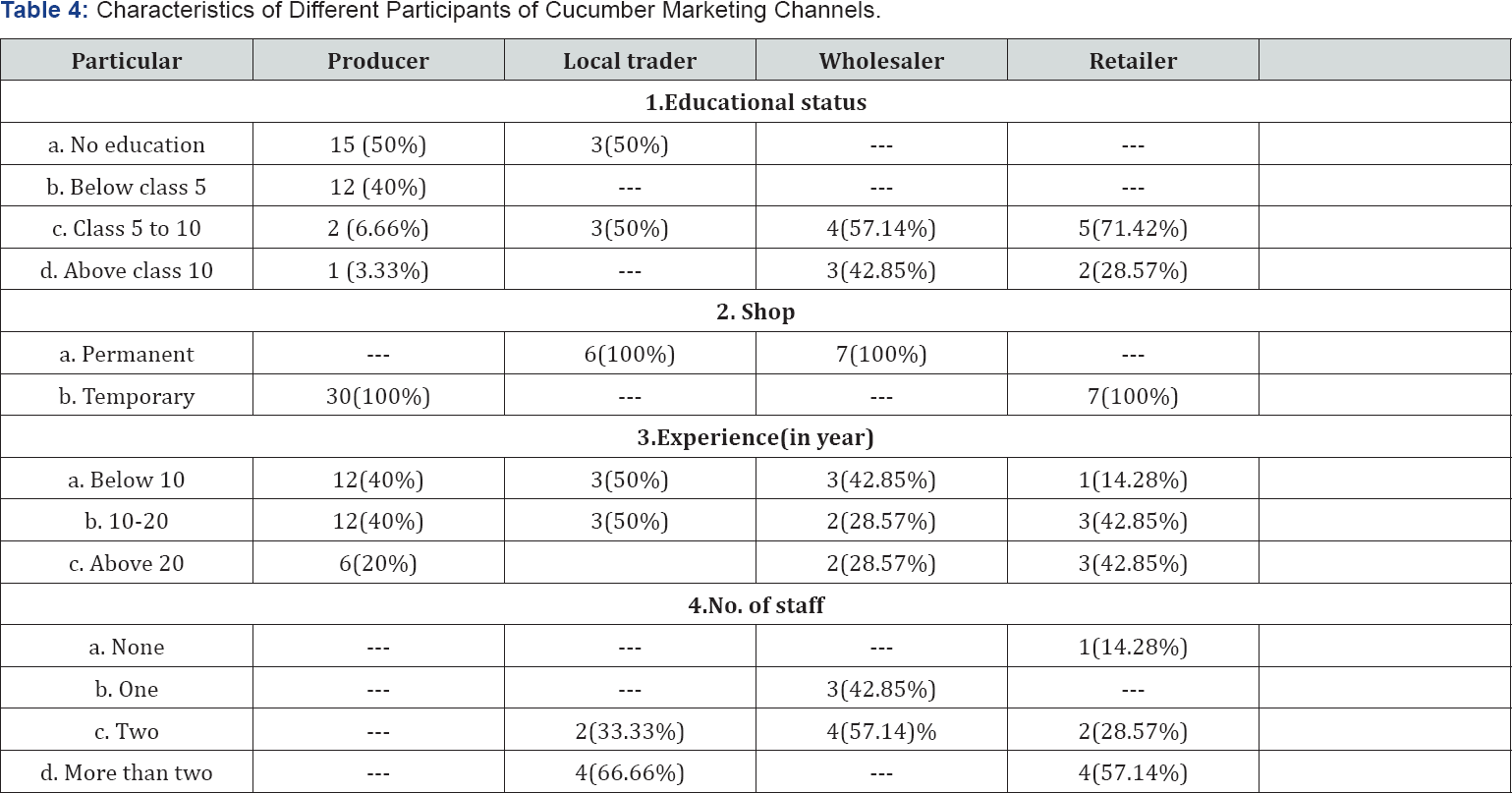
Source: Field survey, 2017.
Marketing functions
Buying, selling and Volume handle: From producers to final users, price found to change many times and each time a new price was determined by the interaction of demand and supply. Pricing of cucumber is done by individual traders. The sellers reported that they did not follow any fixed price. The local traders at farm level purchased cucumber per kg at Tk. 12.11 and sold them at Tk.16.17 again, wholesaler and retailer purchased cucumber at Tk.15.50 and Tk.17.93 respectively and sold them at Tk.16.98 and Tk.20.23 respectively. On an average a local trader, wholesaler and retailer handled respectively 200, 500-800 and 50-100kg cucumber per day. So highest amount of cucumber was handled by the wholesalers followed by local trader and retailer (Table 5).

Source: Field survey, 2017.
Transportation and sources of financing and market information
Farmers transported most of their product by van in the local market of Phulpurupazila, due to short distance (3km) from the production site. The retailers of Mymensingh city used auto, vanetc. for transportation. Another retailer of basabari area purchased cucumber from the wholesale market and they personally carried the products to their shop. The distance between Phulpur to Mymensingh city is 21km. From Table 50% farmers were self-financed and 50% operated their business with own capital and borrowed from different NGOs. In the case of local traders 66.66% of them were self-financed and bank provided funds 33.33 % of local traders. Almost all of the Wholesaler were self-financed (71.42%) and others (28.57%) were own sources and bank loan. Most of the retailers (71.42%) were self-financed and other sources were bank loan (28.57%). So analysis shows that the main source of financing of cucumber trading was own capital. Most of the producer (40%) received their market information from fellow traders. Local traders collected information through observation (50%) and rest (50%) from fellow traders. In case of wholesaler (71.42%) information obtained over telephone or mobile. Most of the retailers (71.42%) received their market information through visit to market and personal observation and (28.57%) information got from fellow traders (Table 6).
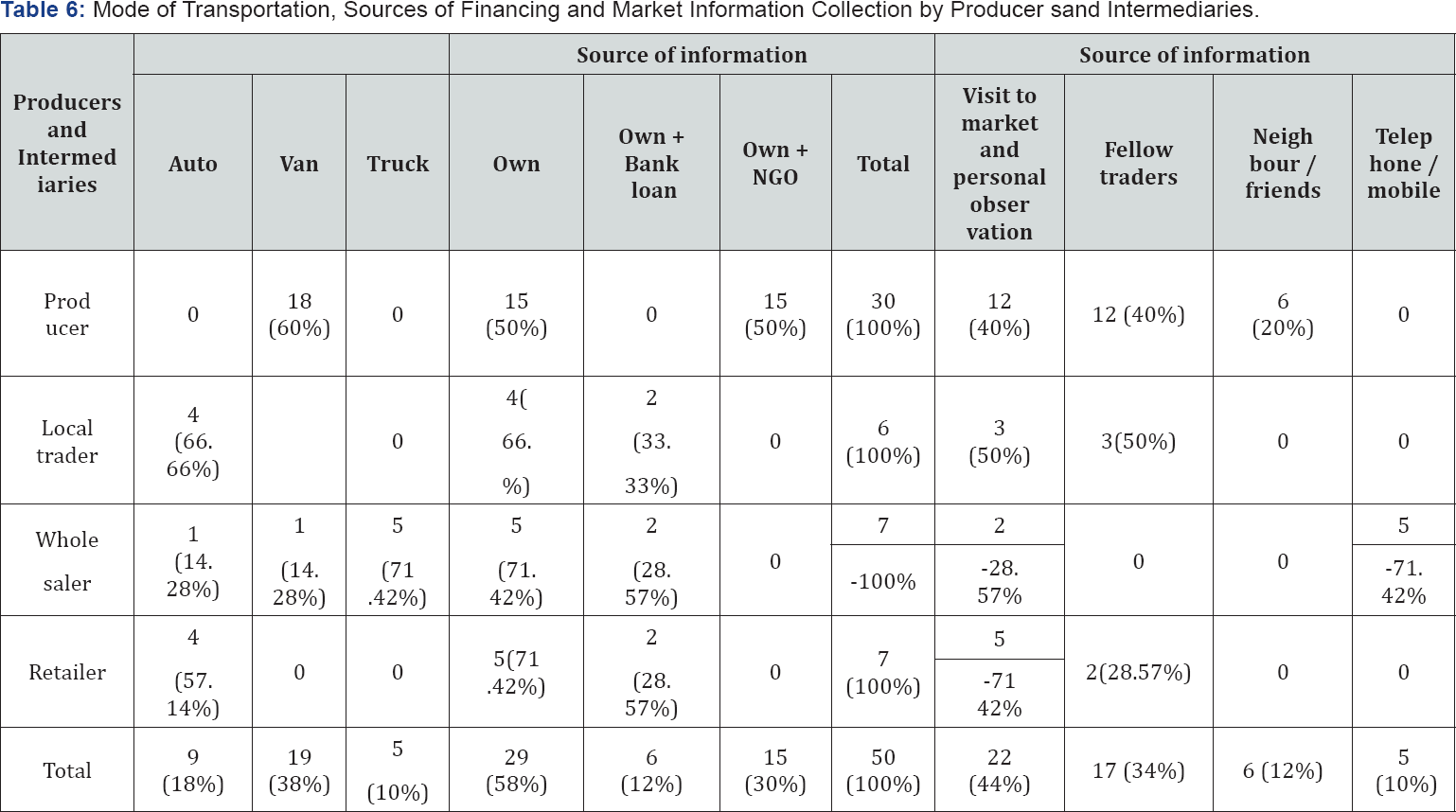
Source: Field survey, 2017.
Marketing cost and margins of cucumber
Marketing cost: The total marketing cost of cucumber comprised of all costs incurred by various intermediaries standing between the farmers and the ultimate consumers. Table 7 indicates that total marketing cost was Tk. 6.16per kg cucumber. Here total retailer cost was 25.59% of total cost, wholesaler spent money 30.07% of total cost and local traders share money 44.31% of total cost. Shop rental cost is the highest cost (19.25%). Next main costs in descending order were transport cost (16.24%), electricity, market toll, assembling cost, and personal expenses.

Source: Field survey, 2017.
Marketing margin
The Table 8 shows that average gross marketing margin was highest for retailer (Tk. 4.23) and lowest for wholesaler (Tk.2.43). Net marketing margin was highest for retailer (Tk. 2.65) and lowest for wholesaler (Tk.0.58). While return on investment was highest for retailer (14.27%) and lowest for wholesaler (Tk.3.34%).

Source: Field survey, 2017.
Seasonal price behavior of cucumber
As Cucumber is perishable and cannot be stored for a long time, so cucumber producers and intermediaries want to sell their products as soon as possible. For this condition when the production of cucumber increased then the price of cucumber decreased. The highest growers price index for cucumber was 135.67 found in the month of October, i.e., growers price of cucumber is 35.67per cent higher than the average growers price in this month and the lowest price index of growers was 60.62 in the month of May i.e., growers price is 39.38 per cent lower than the average growers price in this month Figure 1. After reaching the highest price in the month of October, then price declines till Month and then price rises (Table 9).
Since, seasonal growers price indices of cucumber is bigger in the month of September, October and November, so cucumber producers have to plan to cultivate in such a way so that they can harvest their cucumber in these months, then they will receive higher price. There is a big difference between highest and lowest price indices (135.67-60.62=75.05).
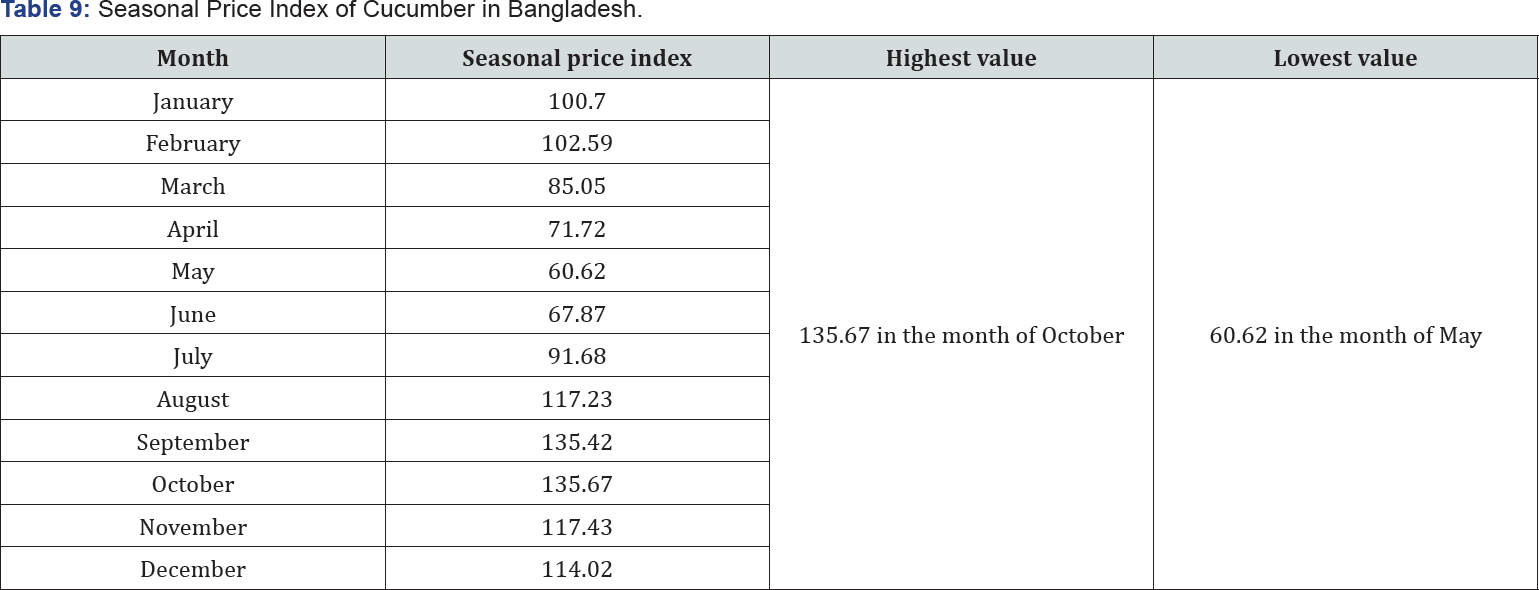
Source: Field survey, 2017.
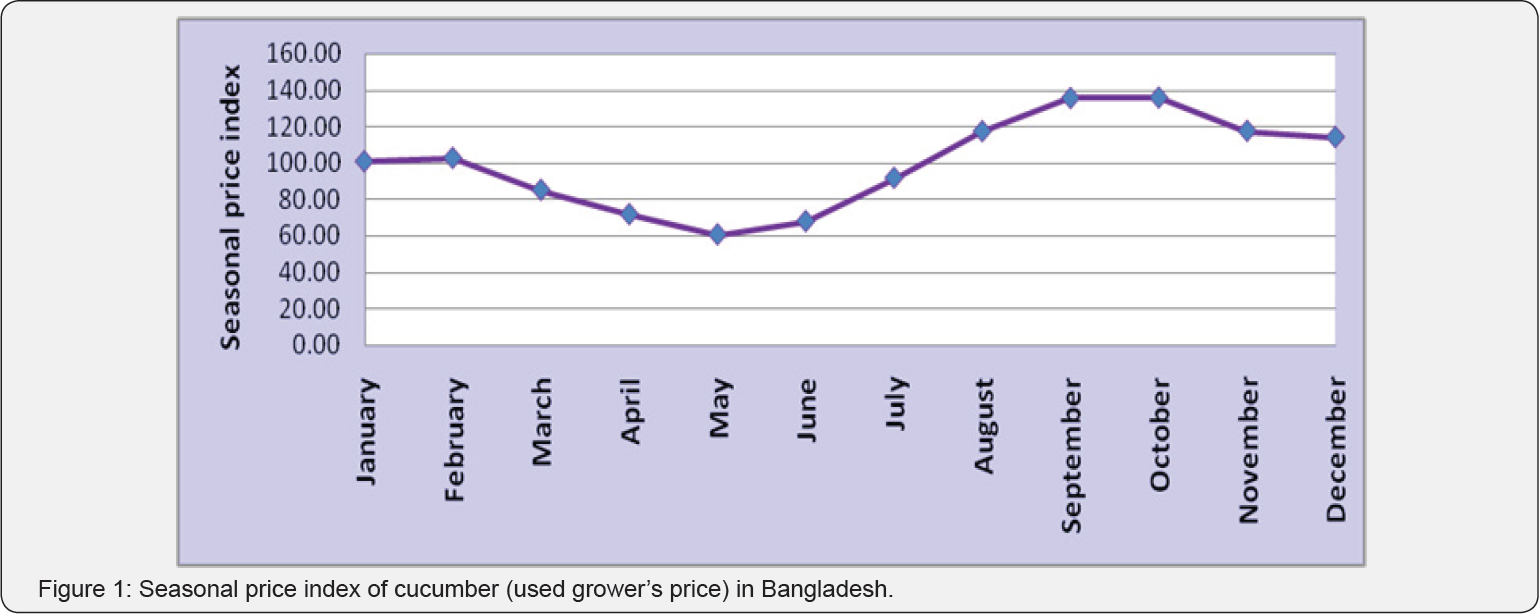
Conclusion
Per acre gross returns of producing cucumber was TK. 115986.87 and per acre total cost was Tk.72824.16.The total marketing cost of the local trader was Tk.2.73 per kg, Tk.1.85 for wholesaler, Tk.1.57 for retailers. The major marketing cost of retailers were electricity cost of cucumber and rent of shop. Net marketing margin of local traders was Tk.1.33 per kg, Tk.0.58 for wholesaler, for retailer Tk.2.65 respectively. Analysis shows that in cucumber business gross and net marketing margin were higher for retailers than other intermediaries and they were local traders, wholesaler and retailers. For movement of cucumber from farmers to the consumers a number of marketing channels were identified. The most common marketing function performed was buying and selling, transportation, packing, grading, financing and market information. Most of the cucumber used to grade on the basis of size, colour and defect. The seasonal price indices of cucumber was the highest (135.67) in the month of October and the lowest (60.62) in May. The present study identified some of the problems and constraints was related to high price and lack of good quality plant, high price of fertilizers and insecticides, lack of scientific knowledge and training, attack by pests and diseases, low market price, environment, lack of extension work, social problems etc. Finally if the modern production, harvesting and post-harvest technology can be made available to farmers and traders and performance of marketing system is to be improved, cucumber farming could be more viable and attractive commercial enterprise which can improved their socioeconomic status and help in alleviating rural poverty in many areas of Bangladesh.
References
- Bangladesh Bureau of Statistics (2014) Statistical Pocket Book of Bangladesh, Statistics Division, Ministry of Planning. Government of the People’s Republic of Bangladesh. Dhaka.
- Maurya GP, Pal V, Singh GP, Meena LK (2015) An economic analysis of cucumber cultivation in Sultanpur District of Uttar Pradesh (India). International Journal of Agricultural Science and Research 5: 23-28.
- Khan Z, Shah AH, Gul R, Majid A, Khan U, et al. (2015) Morpho-agronomic characterization of cucumber germplasm for yield and yield associated traits. International Journal of Agronomy and Agricultural Research 6: 1-6.
- Nahar (2009) An Economic analysis of year round vegetable production in Selected Area of Jessore District. M. S. Thesis. Department of Agricultural Economics. Bangladesh Agricultural University, Mymensingh.
- Suraiya Z (2008) An Economic Analysis of Some Selected Summer Vegetables Production in PurbadhalaUpazila of Netrokona District. MS Thesis, Department of Agricultural Economics, Bangladesh Agricultural University, Mymensingh.
- Siful (2008) An Economic analysis of Cucumber cultivation in Selected Area of Mymensingh District. M. S. Thesis. Department of Agricultural Economics. Bangladesh Agricultural University, Mymensingh.
- Parvin MS (2008). An Economic Study of Alternative Rice and Vegetables Production in Selected Area of Mymensingh District. MS Thesis. Department of Agricultural Economics. Bangladesh Agricultural University, Mymensingh.
- Acharya SS, Agarwal NL (2001) Agricultural marketing in India. Oxford and IBH Publishing co., PVT., Ltd., New Delhi, India pp. 134.
- Miah MTH (1987) Appraisal of deep and shallow tube well irrigation projects in the Tangail district of Bangladesh, M Ec dissertation, University of New England, Armidale, Australia.
- Dillon JL, Hardaker JB (1993) Farm Management Research for Small Farmer Development, Food and Agricultural Organization, Rome, Italy.
- Tomek WG, Robinson KL (1977) Agricultural Product Prices. Cornell University press Ltd., Ithaca and London, pp.165-166.






























